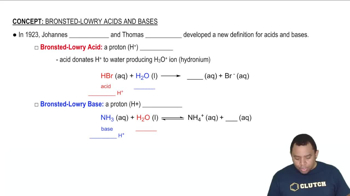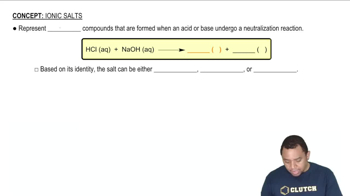Here are the essential concepts you must grasp in order to answer the question correctly.
Acid-Base Theory
Acid-base theory explains how substances can donate or accept protons (H+ ions). According to the Brønsted-Lowry theory, acids are proton donors, while bases are proton acceptors. This concept is essential for classifying salt solutions, as the behavior of the ions in solution determines whether the solution is acidic, basic, or neutral.
Recommended video:
Bronsted-Lowry Acid-Base Theory
Salt Hydrolysis
Salt hydrolysis occurs when an ionic compound dissolves in water and its constituent ions interact with water molecules. This process can lead to the formation of acidic or basic solutions depending on the nature of the ions. For example, cations from weak bases can produce acidic solutions, while anions from weak acids can produce basic solutions.
Recommended video:
pH Scale
The pH scale measures the acidity or basicity of a solution, ranging from 0 (very acidic) to 14 (very basic), with 7 being neutral. Understanding the pH scale is crucial for classifying salt solutions, as it provides a quantitative measure of the concentration of hydrogen ions in the solution, which directly relates to whether the solution is acidic, basic, or neutral.
Recommended video:
 Verified step by step guidance
Verified step by step guidance

